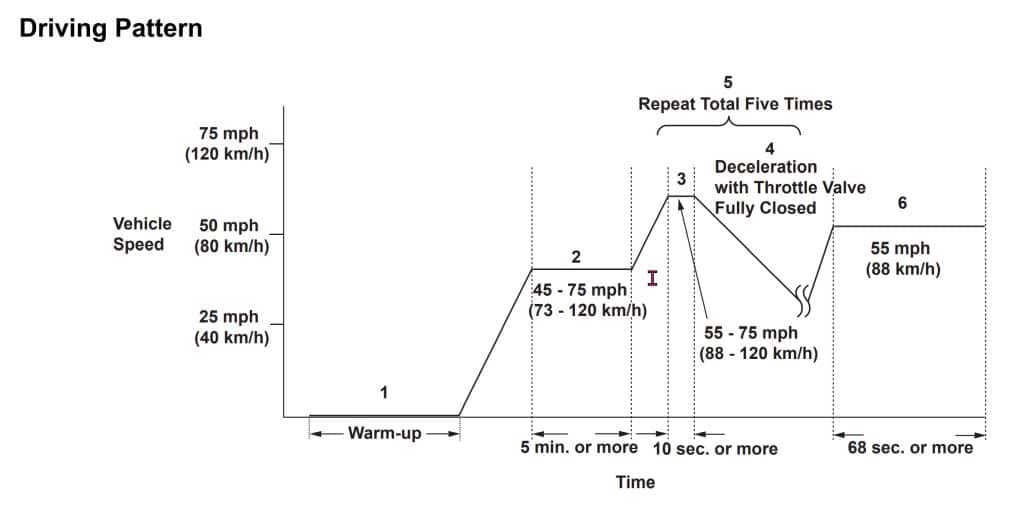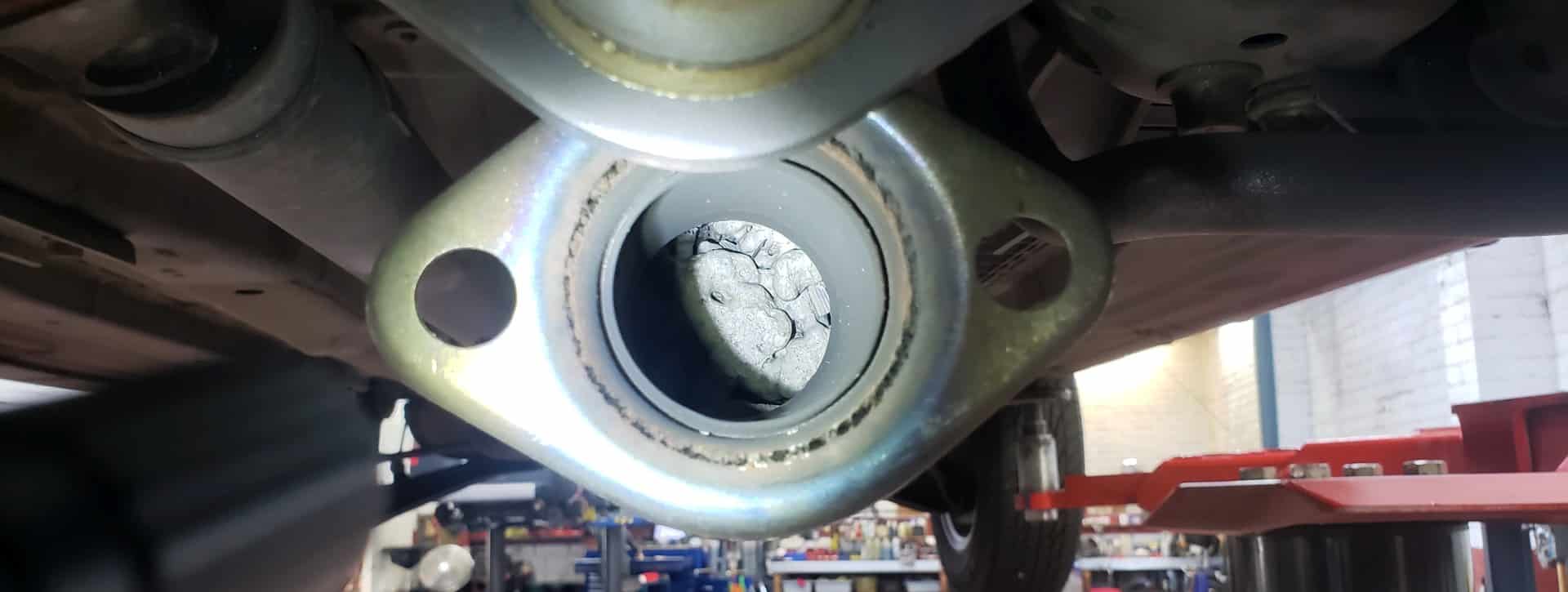How do you get a catalyst monitor to run? Why do you need it to run? Well, in California all vehicles model year 2000 and newer don’t require a tailpipe emissions test. Instead, we check to see if the vehicle’s computer has found any problems that might cause increased emissions during the smog inspection. If the check engine light is on, the car fails. It’s simple test and has reduced the price of smog testing. [Don’t worry, the state increased the certificate fee, so you still get to pay the same amount for your smog test.]
“Ah ha!”, says the crafty consumer, “I’ll just disconnect the battery to clear codes and then go pass the smog test!”
“Not so fast”, says the state, “We’re also going to check to see if the monitors are complete.”
What’s A Monitor?
A few years ago, most drivers (and a few mechanics) had no idea what a monitor is. Since you’re reading this, I’m guessing that you’ve learned what a monitor is, and are pretty frustrated.
You went to the smog station. You failed the smock check. The guy says you’ve got to drive around some more. So you drive around some more, then go back. You fail again. The guy says you’ve got to drive some more. You think, “I’ve already fu@%ing driven the car!” Wash, rinse, repeat — until you have no hair left.
The monitor for the catalytic converter is usually one of the most difficult to get to run. If you’re ready to give up, we’ll do it for you, and if we can’t get it to run, we’ll find out why it’s not running and fix the problem(s), but we charge.
The catalyst drive pattern is almost always something you can do yourself while driving somewhere you needed to go anyway. It’s extremely rare that there’s a problem with the car.
The catalyst monitor is a series of tests the car’s computer (ECM) does to determine if the catalytic converter is working normally. All monitors, including the catalyst monitor, are dependents on sensors.
In the case of the catalyst monitor, the O2 sensors are the key sensors. This is very important to know if the catalyst monitor just plain won’t run, no matter how much you drive. We’ll talk more about that later, but let’s start with the assumption that your car is OK, which is the case almost all of the time.
How many miles to drive before smog check
catalyst monitoring incomplete
There isn’t a magical number of miles that will set your converter monitor to ready. The monitor requires certain conditions to run. By conditions I mean things like vehicle speed, the amount of throttle, and the combination of the two over time. For instance, if you only drive around town, the catalyst monitor will never run, at least not on any car I know of.
Can I pass CA smog with catalyst monitor not ready
As of this writing, maybe. It depends on the car. It’s not permissible for most cars, but there are a few older cars where California has made an exception. Most smog inspection stations will tell you over the phone. Call one and ask. We usually send people to 7 Days a Week Smog in Berkeley.
how to get catalyst monitor ready
I’d love to give you exact catalyst monitor drive cycle instructions, but there are a whole lot of variations.
Here’s one of the worse catalyst drive cycles ever. One car I worked on had to be driven at 50 MPH with a steady throttle for 10 minutes. That’s about 8 miles at the same speed, without slowing down or speeding up. Not only that, but 50 MPH is well under freeway speed when the freeway is clear enough to drive that far without having to slow down.
No wonder the car’s owner couldn’t get the monitor to run!I threw on the hazards endured some dirty looks, but the catalyst monitor inc message switched to catalyst monitor ready, just like it should.
There was nothing wrong with the car, it just required some ridiculous driving to run. By the way, cruise control is often the best way to complete a catalyst monitor.
Another car needed to be driven in 2nd gear to pass part of a monitor. Accelerate to 50 MPH, then decelerate to less than 6 MPH without touching the brake. Repeat at least 5 times. Once again, I had to go out and make new friends on the road, but the monitor passed. There was nothing wrong with the car.
But why won’t the converter monitor ready!?
You may be wondering why you’ve read this far. You came to find out how to get the catalytic converter monitor to pass, and so far, I’ve said nothing other than the car is most likely fine and there are a lot of different obscure driving patterns to get the monitor to run.
Be patient. Patience gets monitors to run. I’m teaching you to fish, not giving you fish. The fish are already out there but hidden in a sea of information that is the internet.
What you need to find is a “drive pattern”; some people call it a “drive cycle”. A drive pattern is almost always provided by the manufacturer on their technical information website.
A drive pattern is a set of instructions for driving that will cause the monitor to run in the least amount of time. Unfortunately, manufacturer’s websites are subscription based.
We subscribe to all of the techinfo sites, so if you’re a customer, we’d be happy to print you a copy for your car. If you’re not our customer, ask your shop for a copy. They’ll likely be willing to help.


Where Can You Find The Drive Pattern For Your Car?
You can also subscribe to a techinfo site for a day. Here are the links for the sites we use.
techinfo.toyota.com
techinfo.subaru.com
techinfo.honda.com
nissan-techinfo.com
mazdaserviceinfo.com
There are other sources for drive patterns. In fact, you may be able to find the drive pattern for your car with a Google search. Try something like “2005 Toyota Tacoma drive pattern”. You’ll likely find some information. The only problem is that the further from the source you get, the more likely the information will be wrong.
For instance, we subscribe to different information services as well, like Alldata, Motologic, and Identifix. They too provide drive patterns, but they don’t always match the drive pattern from the manufacturer’s website.
There are also numerous forums with information on how to complete a drive cycle, but there’s no weighting based on knowledge, so the person offering the advice may be as clueless as you. Regardless, you’ll start to see trends that will help.
What Should You Do If You Have No Access To Technical Information?
If I had no access to information and I needed to run the monitor for the catalytic converter, I’d choose a time and freeway where I could drive without interruption. I’d set the cruise control to 60 MPH and drive for 10 minutes, pull off, let the car idle for a minute, then drive back in the direction I came with the cruise control at 60 MPH. It won’t work for all cars, but it will work for a lot of them.
So, what can cause the monitor to not run? If you drive it EXACTLY like the drive pattern dictates, the monitor should run. It may run and pass, or it may run and fail, but it should run. It’s one of those things that only the team that programmed your ECM may know.
What Sort Of Thing Can Prevent The Converter Monitor From Running?
When a catalyst monitor won’t run, it’s often some undocumented logic. For instance, I’ve found marginal O2 or AF (air/fuel) sensors to be the cause. The O2 sensor monitor has run, and PASSED, but the converter monitor won’t run. After replacing the poorly performing O2 or AF sensor, the catalyst monitor runs on the first drive.
Some manufacturers list enabling conditions and dependencies in their service information. If we’re lucky enough to have this information, it pays to record everything related to any condition or dependency in the live data while performing the drive pattern.
If you know what the computer is looking at, and then you then review the same data, the problem often leaps out at you. Sometimes it’s something stupid, like the car must be in drive to run the monitor. The shifter position switch is bad, so the computer doesn’t think it’s in drive, even though it’s cruising at 60 MPH. The computer won’t run the monitor and doesn’t have any logic built in to flag the bad shifter position switch.
Using Mode 6 Data
Another great resource is “Mode $06” data, at least the decoded version available from factory scan tools. Mode $06 data are the results of the self tests that make up the monitors.
Mode $06 is an OBDII term. The data in it’s raw form is a huge waste of time. It might look something like:
TID $05 / CID $81 C365
You’d find rows and rows of data like this, which you’d then need to compare against tables from the manufacturer to figure out what each TID (Test ID), and CID (Component ID) represent. Then you’ll need to convert the hex numbers to decimal numbers.
But wait, there’s more! Once you figure out what units are being measured, whether their limit is high, low, or both, and whether the actual numbers fall withing the good range, you still won’t know much. The values may look great, but they may be fake. The computer may put in numbers that are in the “good” range as a place holder until that portion of the monitor is complete.
OK. So generic OBDII Mode $06 is useless unless you like puzzles and wasting your customer’s money. However, OEM monitor results are very useful indeed. With OEM monitor results you can see which parts of the tests have run and passed, and which parts haven’t run. If you use a little automotive knowledge, common sense, and logic, you can figure out how to drive for the incomplete portions of the test to run.
Look At Dependencies In The Mode 6 Data, Not Just the Catalyst Monitor
The other handy thing is you can check the Mode $06 data for the catalyst monitor’s dependencies. For instance, the catalyst monitor will rely on the air fuel ratio sensor and oxygen sensor for it’s test routine. If you check the air fuel ratio sensor test results, and it just barely passed, that might be why the converter monitor isn’t running.
This sort of thing frequently isn’t documented, just as 90% of the ECM’s logic isn’t documented. However, I’ve made this type of guess several times, and found that replacing a marginal sensor will allow the converter monitor to complete, when nothing else has worked.
If the car has more that one monitored converter, the Mode $06 data may show you that one converter has passed it’s tests, but the other(s) have not. Since the conditions to run the monitor were met, and one monitor ran and passed, it’s a safe bet that you’ll find out what’s keeping the monitor from running by scrutinizing causes that would be particular to the incomplete bank.
